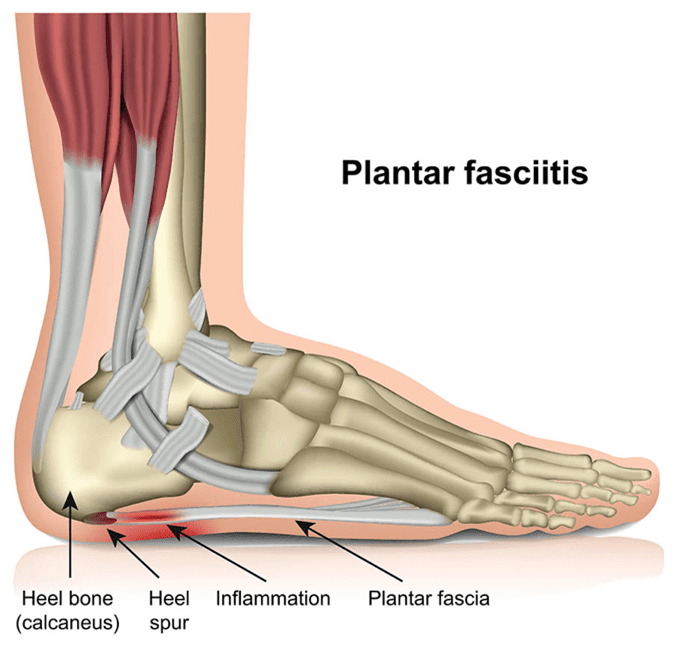By Nathan Ting, Physiotherapist
Are you a regular runner? Perhaps a bustling bushwalker always seeking out new trails? Do you have seemingly unexplained pain or tightness at the bottom of your foot or heel that just doesn’t seem to be getting better? Chances are, you have plantar fasciitis (fash-ee-eye-tis 😆) – but what exactly does that mean?
What it is
The plantar fascia is a band of connective tissue that starts under your heel and extends through to the bottom of the toes. It plays an important role in providing structural support to the foot during activities such as walking and running. Plantar fasciitis is the most common culprit of heel pain and often occurs when the plantar fascia is overloaded and becomes inflamed/sustains micro-tears, often as a result of a sudden increase in activity or load (Buchanan & Kushner, 2017).


Often with plantar fasciitis you will feel pain on the inside of your heel. Most noticeable on the first few steps of walking after a period of rest or after a prolonged period of time on your feet (Martin et. al., 2014). That being said, it can be tricky to differentiate by yourself what might be plantar fasciitis among a host of other potential conditions, especially when considering the nature and number of possible injuries and conditions around the foot and ankle. It is always advisable to address the issue as early as possible and seek professional guidance for a proper diagnosis if you are unsure about where your pain might be coming from.
What can be done?
There are a variety of effective approaches when dealing with plantar fasciitis – common treatment strategies include calf and plantar fascia specific stretching (Siriphorn & Eksakulkla, 2020), trigger point dry needling (Llurda-Almuzara et.al., 2021) and manual therapy (Fraser et. al., 2018). A period of de-loading may also be required to give the plantar fascia some time to recover, alongside an exercise program designed to specifically stretch and strengthen the calf, foot and hip (Kamonseki et. al., 2016).
How can we help?
Here at Pinnacle Spine & Sports, our model of care is to Repair, Retrain and Maintain. We will firstly ask questions regarding your pain and perform a thorough physical examination to actually make sure it is or isn’t plantar fasciitis. Following this, a tailored treatment program will be created to meet your specific needs. This will include immediate treatment likely including a combination of hands-on therapy as necessary to facilitate early repair. Exercises and lifestyle modifications appropriate to your stage of recovery will be taught to encourage optimal movement patterns and help you to maintain good, pain-free function.
If you have any questions or would be interested in making an appointment with any of our clinicians, feel free to give us a call or book online on our website.

References:
Buchanan, B. K., & Kushner, D. (2017). Plantar fasciitis.
Fraser, J. J., Corbett, R., Donner, C., & Hertel, J. (2018). Does manual therapy improve pain and function in patients with plantar fasciitis? A systematic review. Journal of Manual & Manipulative Therapy, 26(2), 55-65.
Kamonseki, D. H., Gonçalves, G. A., Liu, C. Y., & Júnior, I. L. (2016). Effect of stretching with and without muscle strengthening exercises for the foot and hip in patients with plantar fasciitis: A randomized controlled single-blind clinical trial. Manual therapy, 23, 76-82.
Llurda-Almuzara, L., Labata-Lezaun, N., Meca-Rivera, T., Navarro-Santana, M. J., Cleland, J. A., Fernández-de-Las-Peñas, C., & Pérez-Bellmunt, A. (2021). Is dry needling effective for the management of plantar heel pain or plantar fasciitis? An updated systematic review and meta-analysis. Pain Medicine, 22(7), 1630-1641.
Martin, R. L., Davenport, T. E., Reischl, S. F., McPoil, T. G., Matheson, J. W., Wukich, D. K., … & Godges, J. J. (2014). Heel pain—plantar fasciitis: revision 2014. Journal of Orthopaedic & Sports Physical Therapy, 44(11), A1-A33.
Siriphorn, A., & Eksakulkla, S. (2020). Calf stretching and plantar fascia-specific stretching for plantar fasciitis: A systematic review and meta-analysis. Journal of bodywork and movement therapies, 24(4), 222-232.
